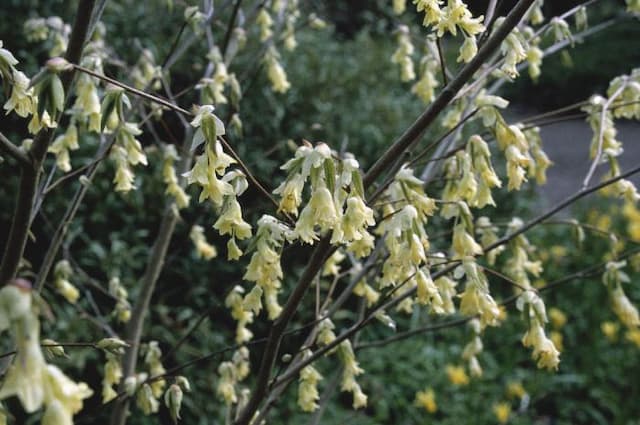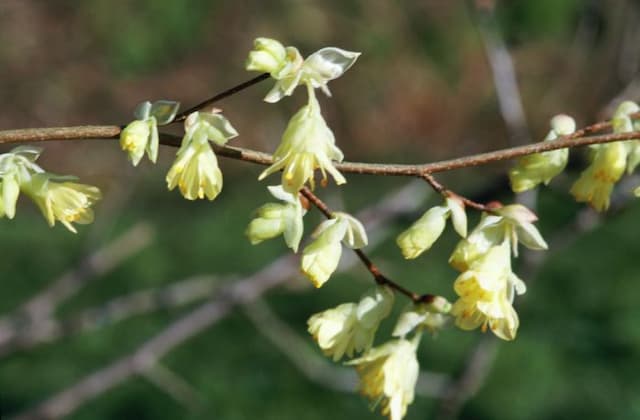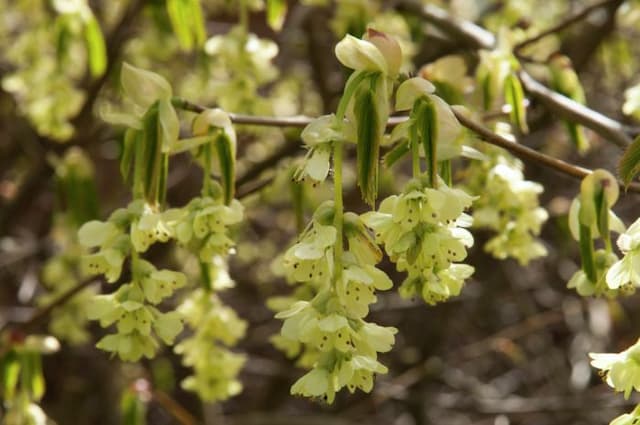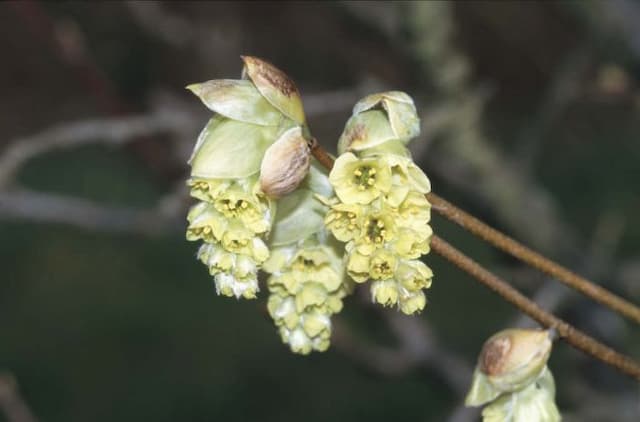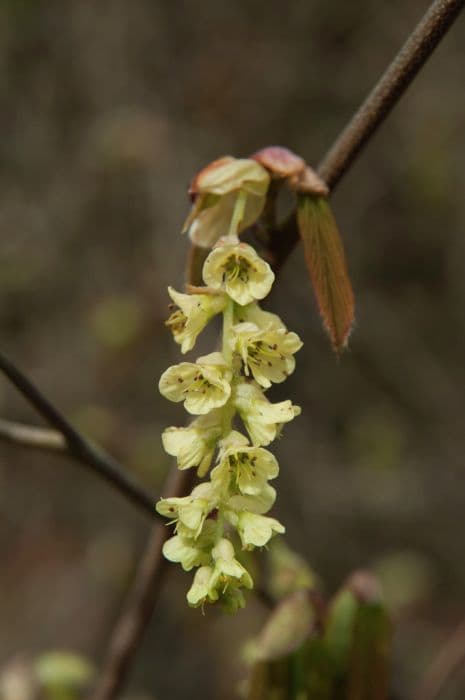Redbud hazel Disanthus cercidifolius

ABOUT
Disanthus cercidifolius, commonly known as the red bud hazel, is a deciduous shrub that is noted for its attractive foliage and shape. The leaves of the red bud hazel resemble those of redbud trees, with a heart-like shape, giving it a distinctive and appealing texture in the landscape. These leaves emerge in spring with a soft green color. As the seasons change, the foliage transitions through a remarkable palette of colors. In the fall, the leaves become a fiery display of reds, oranges, and purples, creating a striking visual spectacle before they drop off for the winter. The flowers of the red bud hazel are small but interesting, favoring a modest appearance. They are typically a purplish color and bloom in clusters during the spring before the foliage fully expands. This gentle floral display can add a subtle charm to the plant's overall presence, although it is the foliage that truly steals the show. Adding to its elegant appearance, the bark of red bud hazel has a smooth texture, and on mature specimens, it can provide visual interest during the winter months when the leaves have fallen. The overall shape of the red bud hazel is rounded and it possesses an open branching structure, giving it an airy feel. Throughout the year, the red bud hazel creates a dynamic spectacle, as it transitions through its seasons and continues to provide unique beauty to any garden space where it thrives.
About this plant
 Names
NamesFamily
Hamamelidaceae
Synonyms
Redbud Hazel, Long-stalked Disanthus
Common names
Disanthus cercidifolius.
 Toxicity
ToxicityTo humans
Disanthus cercidifolius, commonly known as redbud hazel, isn't widely recognized for being poisonous to humans. There is limited information on its toxicity as it is not a commonly reported cause of poisoning. However, in the absence of specific toxicology data, it is generally advisable to avoid ingesting any plant material that is not known to be safe. If one suspects poisoning from any plant, they should seek medical attention.
To pets
Redbud hazel is not commonly known to be toxic to pets. However, as with humans, there is limited information available regarding its toxicity to animals due to the lack of common incidents or studies. It’s always best to prevent pets from ingesting plants that are not known to be safe. If a pet is suspected to have ingested redbud hazel and is showing signs of illness, it is important to contact a veterinarian.
 Characteristics
CharacteristicsLife cycle
Perennials
Foliage type
Deciduous
Color of leaves
Green
Height
6-10 feet (1.8-3 meters)
Spread
6-10 feet (1.8-3 meters)
Plant type
Shrub
Hardiness zones
5
Native area
Japan China
Benefits
 General Benefits
General Benefits- Ornamental Appeal: Disanthus cercidifolius, known as red bud hazel, has attractive heart-shaped leaves that change color with the seasons, displaying hues of green, red, and purple, providing visual interest throughout the year.
- Seasonal Interest: It offers a rich display of autumn colors, which can be especially valuable in temperate landscapes that experience distinct seasonal changes.
- Shade Tolerance: Red bud hazel can grow well in partial shade, making it a suitable choice for woodland gardens or areas with dappled light.
- Low Maintenance: Once established, it requires minimal care, as it is relatively drought-tolerant and does not have high water or fertilization requirements.
- Pest Resistance: This plant is generally resistant to pests and diseases, reducing the need for chemical interventions.
- Wildlife Attraction: The flowers of red bud hazel may attract pollinators like bees, while birds may enjoy the seeds, thus contributing to local biodiversity.
- Compact Size: Its size and slow growth rate make it suitable for smaller gardens or spaces where a non-invasive plant is desired.
 Medical Properties
Medical PropertiesThis plant is not used for medical purposes.
 Air-purifying Qualities
Air-purifying QualitiesThis plant is not specifically known for air purifying qualities.
 Other Uses
Other Uses- Disanthus cercidifolius, commonly known as redbud hazel, can be used in creating naturalistic garden designs, blending seamlessly into woodland settings due to its organic form and vivid fall coloration.
- In bonsai cultivation, redbud hazel's attractive foliage and graceful growth habit make it a unique specimen for miniature landscapes.
- Redbud hazel's branches may be used as natural art installations or rustic décor, especially when they showcase their interesting fall colors.
- As a source of shade in small gardens, redbud hazel trees provide a cooling canopy during hot summer months while remaining compact in size.
- The distinct heart-shaped leaves can be studied for educational purposes in botany classes to compare leaf morphology among different plant species.
- Redbud hazel is an excellent choice for creating privacy screens in residential areas, due to its dense foliage.
- Featuring redbud hazel in photography and painting can capture the essence of autumn through its vibrant foliage, providing inspiration for various art forms.
- Its durable wood is occasionally crafted into small woodworking projects such as decorative bowls or intricate carvings.
- Redbud hazel leaves can serve as a natural mulch and soil conditioner as they decompose, which benefits garden beds.
- The tree’s compact and rounded shape makes it a suitable candidate for urban streetscapes and parks where space is limited.
Interesting Facts
 Feng Shui
Feng ShuiThe Redbud Hazel is not used in Feng Shui practice.
 Zodiac Sign Compitability
Zodiac Sign CompitabilityThe Redbud Hazel is not used in astrology practice.
 Plant Symbolism
Plant Symbolism- Uncommon Beauty: Disanthus cercidifolius, commonly known as redbud hazel, showcases a unique and striking beauty with its heart-shaped leaves and vibrant fall colors, symbolizing the appreciation of unconventional beauty.
- Change and Transformation: The redbud hazel's dramatic change in leaf color during the fall season represents the ability to transform and adapt to new conditions.
- Rarity and Value: As it's not as common in gardens as other plants, the redbud hazel can denote rarity and the idea that rarity can bring increased value or significance.
- Harmony with Nature: This plant's ability to blend into natural woodland settings suggests a symbol of living in harmony with nature and the environment.
 Water
WaterTo properly water your Redbud Hazel, it is crucial to maintain consistently moist soil, especially during the first growing season to establish a deep root system. Water the plant deeply once a week, providing about 1 to 1.5 inches of water each time. During periods of drought or extreme heat, you may need to water twice weekly. As the plant matures, it will become more drought-tolerant, and you can reduce watering frequency. Always check the soil moisture before watering and adjust your schedule to avoid over-watering, as Redbud Hazel does not like to sit in waterlogged soil.
 Light
LightThe Redbud Hazel thrives in partial shade to full sun exposure. It prefers a location that receives morning sunlight with dappled afternoon shade or a spot with bright, indirect light throughout the day. Avoid placing it in deep shade, as this can reduce flowering and foliage density. The ideal spot for Redbud Hazel is one that mimics its natural woodland environment, offering a mix of light and protection from the harsh afternoon sun.
 Temperature
TemperatureRedbud Hazel is best suited to a temperate climate with cool to moderate temperatures. It can withstand occasional dips down to around 0 degrees Fahrenheit, but its ideal growing conditions are between 60 and 75 degrees Fahrenheit. Avoid exposure to extreme heat or prolonged temperatures above 85 degrees Fahrenheit, as this can stress the plant and lead to leaf scorch.
 Pruning
PruningPrune your Redbud Hazel to maintain its shape and remove any dead or damaged branches. Pruning is best done in late winter or early spring before new growth starts. Annually thinning out older branches can help encourage more prolific blooms and improve air circulation within the canopy. Always use clean, sharp tools and make cuts at a slight angle to promote healing.
 Cleaning
CleaningAs needed
 Soil
SoilRedbud hazel prefers moist, well-draining soil rich in organic matter with a slightly acidic to neutral pH, ranging from 5.5 to 7. The best soil mix would be a blend of loamy garden soil, peat or leaf mold, and perlite or sand to ensure good drainage.
 Repotting
RepottingRedbud hazel does not require frequent repotting due to its slow growth; it should generally be repotted every 2-3 years or when it outgrows its pot.
 Humidity & Misting
Humidity & MistingRedbud hazel thrives in moderate to high humidity levels, ideally between 40% and 60%, but it is quite adaptable and does not require strictly controlled humidity.
 Suitable locations
Suitable locationsIndoor
Place Redbud hazel in bright, indirect light indoors.
Outdoor
Plant Redbud hazel in part shade with moist soil.
Hardiness zone
5-8 USDA
 Life cycle
Life cycleDisanthus cercidifolius, commonly known as redbud hazel, begins its life cycle with seed germination, which is dependent on appropriate moisture and temperature conditions. After germination, the seedling grows into a young plant with a central stem and heart-shaped leaves characteristic of the species. The juvenile growth phase involves the development of the root system and vegetative structures, gradually maturing over several years. As an adult, the redbud hazel reaches reproductive maturity and produces small, inconspicuous flowers that are wind-pollinated, followed by the development of fruit that contains seeds for the next generation. During autumn, the plant is known for its vivid fall foliage, displaying a range of colors from yellow to red before leaf drop. Finally, redbud hazel enters a period of dormancy during the winter months, conserving energy before the new growth cycle begins in spring.
 Propogation
PropogationPropogation time
Early spring
The most popular method of propagation for Disanthus cercidifolius, commonly known as redbud hazel, is through seed. The ideal time to collect seeds is in late fall when the seed capsules have ripened and dried. To propagate redbud hazel by seed, one must first stratify the seeds for about 90 to 120 days at temperatures around 40 degrees Fahrenheit (4.4 degrees Celsius) to mimic winter conditions and break seed dormancy. After stratification, plant the seeds about 1/4 inch deep (approximately 6 millimeters) in a well-drained seed-starting mix. Keep the soil consistently moist but not waterlogged. Germination can be slow and irregular, so patience is key. Seedlings can be transplanted to individual pots once they have developed true leaves and are large enough to handle.
